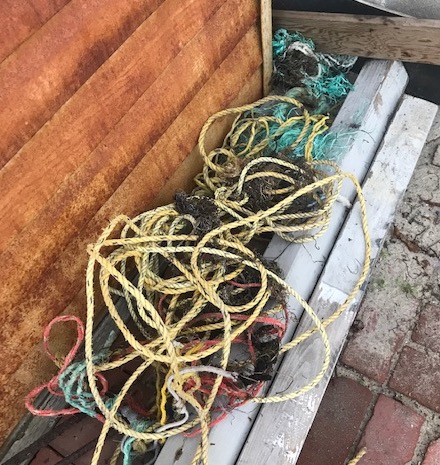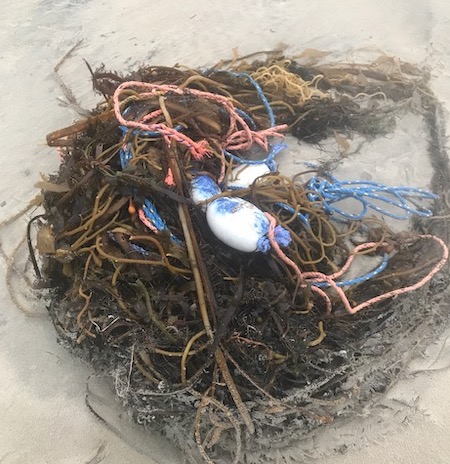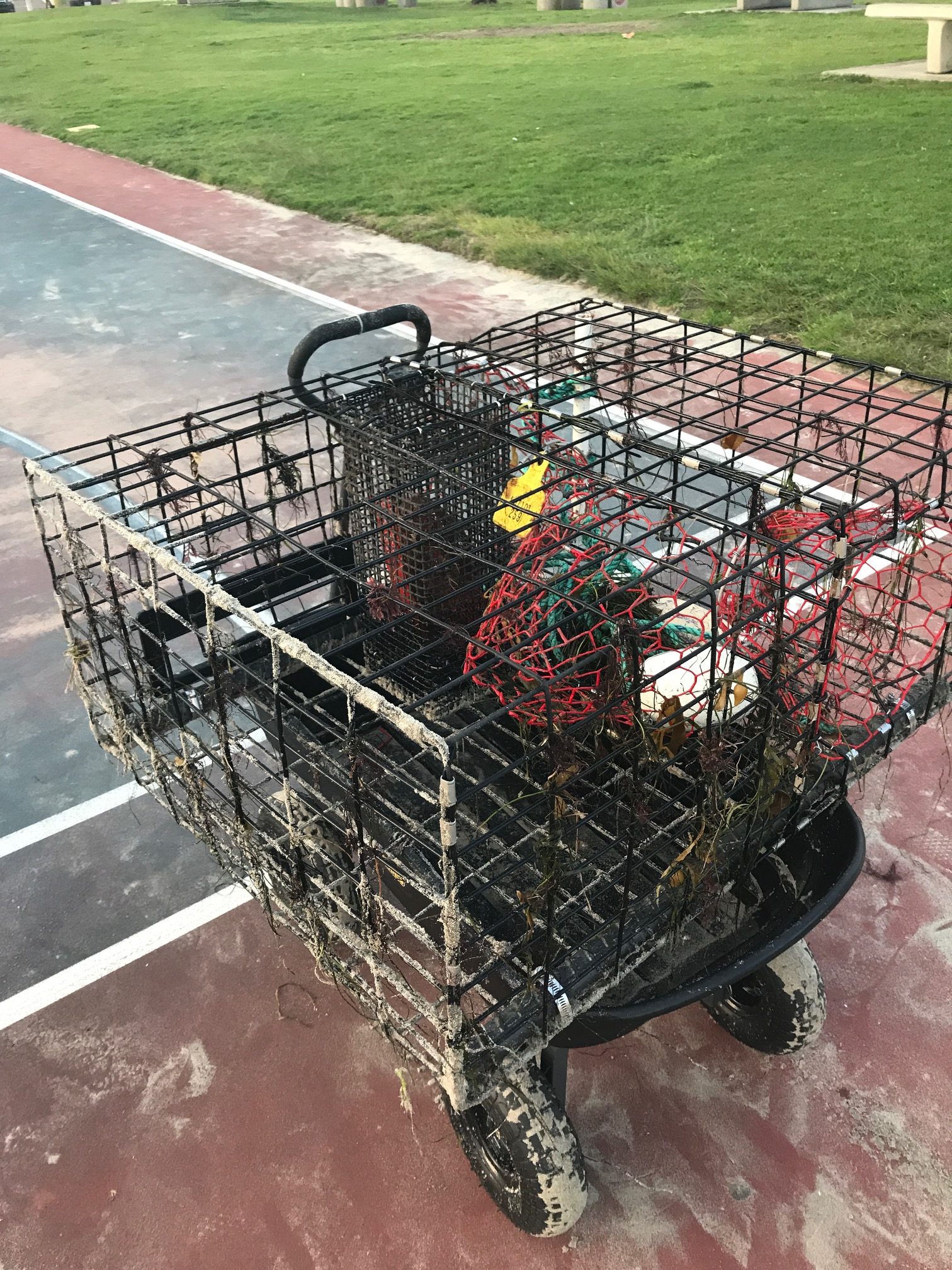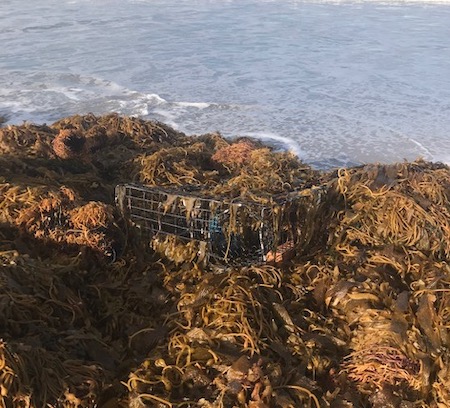Fortunately in my hood we do not have that many ghost nets that wash ashore here in San Diego, at least not like they have in Hawaii and Florida. Maybe I will get 10 Crab pots and they are usually so damaged and entangled in seaweed that the beach screeners pick them up and put in the landfill. The fishing lines are usually broken apart usually in little pieces, but I would estimate that I only pick up around 50 pounds and 5- 6 buoys. That is nothing compared to these beach clean ups I follow on Instagram. That stuff is heavy.. I don’t know how they do it!

A Few Stories (See Images and full articles on our Pinterest Board Ghost Nets
- PINELLAS COUNTY, Fla. — It’s estimated nearly 10,000 abandoned crab traps are lost in Tampa Bay, creating hazards for anglers and senselessly killing marine life.
- 2018: Not far off the islands of the Republic of Vanuatu, a deserted trawl-fishing net undulates in the azure tropical Pacific.
- 300 olive ridley turtles, an endangered species, were found dead by Mexico’s federal agency for environmental protection this week. They were apparently trapped in an abandoned fishing net. Some had been floating under the Mexican sun so long that their shells had dried and cracked. (Inews)
- UK: Scientists concluded as many as 4,000 dolphins could have been killed by fishing nets after 1,000 dead dolphins washed up on shore
- A half mile stretch of nylon net was once found in Lake Superior, an estimated 15 years after being lost. In that time, it had gathered 100 pounds of fish.
- 2016 Australian authorities removed seven ghost nets weighing more than 29 tonnes from the Timor and Arafura seas.
- Cayman Island: solid net of dead, decomposing fish and sharks,” around mid-April. He shared video footage of the mass of dead fish with …
- Maryland: A 1,500-pound mass of tangled, derelict fishing net that looked “like it was breathing” slowly comes aboard a TowBoatUS boat in Ocean City, Md.
- Net Patrol has already removed 47,000 pounds of marine debris off of Kauai’s coastlines.
- The abandoned fishing net weighed an estimated 11.5 tons and had become a legend among the experts working in Hawaii’s Papahanaumokuakea Marine National Monument
- Hawaii: The monster clump of nets estimated to weigh about two to three tons was found in the shore-break and took nearly 40 volunteers two days to break apart using handsaws, an electric saw and scissors.
- WASHINGTON, D.C., March, 2019 — More than 4 million pounds of derelict fishing gear that would otherwise have become marine debris has been collected, recycled and converted into energy, thanks to Fishing for Energy, a partnership between the National Fish and Wildlife Foundation (NFWF), the NOAA Marine Debris Program, Covanta and Schnitzer Steel Industries.
This is all good news that more than 4 million pounds of fishing gear have been collected and converted!! Sadly that is only 4 million out of the estimated 700 Million pounds that are floating in our ocean .

WASHINGTON, D.C., (Press Release) March, 2019 — More than 4 million pounds of derelict fishing gear that would otherwise have become marine debris has been collected, recycled and converted into energy, thanks to Fishing for Energy, a partnership between the National Fish and Wildlife Foundation (NFWF), the NOAA Marine Debris Program, Covanta and Schnitzer Steel Industries.
Over the past decade, the Fishing for Energy partnership has worked directly with 55 U.S. fishing communities in 12 states by offering no-cost solutions to recycle derelict and retired gear. Through the installation of collection bins at strategic ports, local communities have been able to responsibly dispose of fishing traps and nets that are no longer in use, thus preventing them from entering U.S. waterways and coastlines.

“In the ten years since the Fishing for Energy partnership was launched, participating ports have played a key role in promoting this free program to fishermen and local communities,” said Jeff Trandahl, executive director and CEO of NFWF. “Together, we have created a solution that benefits wildlife, people and local economies, and we look forward to continuing our efforts in the future.”

Fishing for Energy collection bins span the east and west coasts. Since Wellfleet, Mass. installed its bin in 2008, the port has collected more than 540,000 pounds of derelict fishing gear. A bin in Newport, Ore. has collected approximately 411,000 pounds since 2009, and one in Point Judith, R.I. has collected approximately 410,000 pounds since 2008. This success would not be possible without strong communications support that spreads word of the program through word-of-mouth, on-site signage, outreach through fishing cooperatives or marine supply stores, and digitally through newsletters, newspapers and social media.
“We are pleased to be part of this public-private partnership that works with fishing communities across the nation to properly dispose of fishing gear so it doesn’t become marine debris,” said Nancy Wallace, director for the NOAA Marine Debris Program.
Local communities play a key role in Fishing for Energy’s success. The partnership has directly engaged more than 1,000 fishermen in recycling and converting unwanted gear into energy.
“Fishermen and local community groups are essential to our success,” said Kenneth Armellino, Covanta’s director of environmental science and community affairs. “With their active participation, we are able to recycle valuable metals and recover renewable energy from the remaining material at Covanta Energy-from-Waste facilities. Over the past ten years, we have been able to generate enough electricity from derelict gear and marine debris to power over 44,000 homes for one year.”

To learn more about this and other efforts under the Fishing for Energy program, please visit our website. Here you can also find information about the program’s marine debris removal and innovation in gear technology, which is currently accepting 2019 grant proposals to support strategies that reduce the impacts of derelict fishing gear in marine and coastal environments.
Watch this video to learn more about the Fishing for Energy partnership: https://www.nbcnews.com/nightly-news/video/fishing-for-energy-ocean-debris-turned-into-fuel-in-florida-1216326211651
About the National Fish and Wildlife Foundation
Chartered by Congress in 1984, the National Fish and Wildlife Foundation (NFWF) protects and restores the nation’s fish, wildlife, plants and habitats. Working with federal, corporate and individual partners, NFWF has funded more than 4,500 organizations and generated a conservation impact of more than $5.3 billion. Learn more at www.nfwf.org.
About Covanta
Covanta is a world leader in providing sustainable waste and energy solutions. Annually, Covanta’s modern Energy-from-Waste facilities safely convert approximately 22 million tons of waste from municipalities and businesses into clean, renewable electricity to power one million homes and recycle approximately 600,000 tons of metal. Through a vast network of treatment and recycling facilities, Covanta also provides comprehensive industrial material management services to companies seeking solutions to some of today’s most complex environmental challenges. For more information, visit covanta.com.
About NOAA
NOAA’s mission is to understand and predict changes in the Earth’s environment, from the depths of the ocean to the surface of the sun, and to conserve and manage our coastal and marine resources. The NOAA Marine Debris Program, within the Office of Response & Restoration, is the federal lead on marine debris. For more information visit: www.marinedebris.noaa.gov.
About Schnitzer Steel Industries, Inc.
Schnitzer Steel Industries, Inc. is one of the largest manufacturers and exporters of recycled metal products in North America with operating facilities located in 23 states, Puerto Rico and Western Canada. Schnitzer has seven deep water export facilities located on both the East and West Coasts and in Hawaii and Puerto Rico. The Company’s integrated operating platform also includes auto parts stores with approximately 5 million annual retail visits. The Company’s steel manufacturing operations produce finished steel products, including rebar, wire rod and other specialty products. The Company began operations in 1906 in Portland, Oregon.
